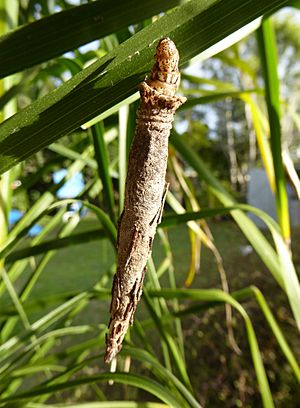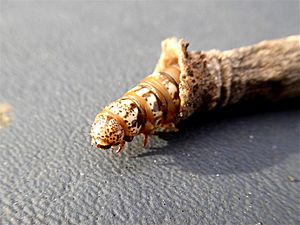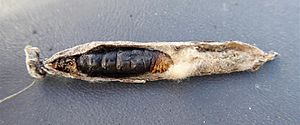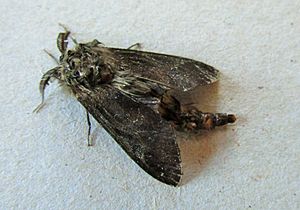Common bag moth facts for kids
Quick facts for kids Common bag moth |
|
|---|---|
 |
|
| Liothula omnivora caterpillar | |
| Scientific classification | |
| Kingdom: | |
| Phylum: | |
| Class: | |
| Order: | |
| Family: |
Psychidae
|
| Genus: |
Liothula
|
| Species: |
L. omnivora
|
| Binomial name | |
| Liothula omnivora Fereday, 1878
|
|
| Synonyms | |
|
|
The Liothula omnivora, also known as the common bag moth, is a special kind of moth found only in New Zealand. It belongs to a group of moths called bagworms. Māori people have several names for these interesting creatures, like pū a Raukatauri (meaning 'flute of Raukatauri', the goddess of music), whare atua ('house of the spirit'), or kopi ('shut').
There are more than 50 types of bagworms in New Zealand, and at least two of them are from the Liothula group.
Contents
About the Common Bag Moth
This moth was first described by a scientist named Richard Fereday in 1878.
The Caterpillar and Its Bag
Just like other bagworms, the L. omnivora caterpillar builds a unique home for itself. It makes a small, cone-shaped bag out of silk. This bag is like a portable house that the caterpillar carries everywhere. It helps the caterpillar hide from predators and keeps it safe.
As the caterpillar grows, it makes its bag longer at the wide end. The caterpillar holds onto the inside of the bag with special hooks on its front legs. This lets it stick its head and front body out while dragging its bag behind. If it feels danger, it quickly pulls itself completely inside the bag and closes the opening tightly.
The caterpillar starts building its bag just a few days after hatching. At first, the bag stands up straight. But as the caterpillar gets bigger, the bag hangs down behind it.
The outside of the bag is often decorated with small pieces of leaves and bark. The way these pieces are placed can tell you if the caterpillar is a male or a female! Females usually have fewer pieces, mostly near the narrow end of the bag. Males, however, attach many pieces all along their bag.
The caterpillar itself has a head and chest that are black or brown with white spots. The rest of its body is plain brown. Female caterpillars grow larger than males. For example, the bags of female caterpillars ready to turn into moths are usually about 45 millimeters long, while male bags are about 42 millimeters.
The scientific name omnivora means "eats everything." This is true for these caterpillars! They eat a very wide variety of plants, both native and non-native. They feed on the leaves of shrubs and trees, mostly at night. Sometimes, they can even wrap their silk so tightly around twigs that it stops the plant's sap from flowing, causing strange bumps to grow on the twigs.
From Pupa to Adult Moth
Caterpillars usually turn into pupae (the stage before becoming an adult moth) during winter. When a caterpillar is ready to pupate, it attaches its bag permanently to a twig or a larger surface using a strong silk band. Then, it closes both ends of the bag and adds an extra layer of silk inside. The caterpillar then changes into a pupa inside this secure bag.
Here's something very interesting: only the male Liothula omnivora turns into a flying moth! The adult female never leaves her bag. She doesn't have wings and her body is very simple, mostly just an abdomen with tiny head and chest parts.
The male moth is hairy and black with see-through wings. Its body tapers to a point. Its wingspan (how wide its wings are when spread out) is about 28 to 38 millimeters.
Male moths usually come out of their pupa early in the morning. When it's time to emerge, the male pupa pushes its way to the narrow opening of the bag. It sticks the front part of its body out. Spines on its body hold it in place while the pupa skin splits open, and the adult male moth comes out. It then holds onto the bag while its wings expand and get hard.
When male and female moths mate, the male uses a special long part of its body to reach into the narrow end of the female's bag. The female lays her eggs inside her bag and then dies. The tiny new caterpillars hatch and leave the bag through the narrow end. They can crawl away, lower themselves down on silk threads, or even be carried by the wind to new places.
Natural Enemies
L. omnivora caterpillars are often attacked by other insects called parasites. These include tachinid flies and ichneumonid wasps.
Tachinid flies, like Pales feredayi, lay their eggs on leaves. When the bagworm caterpillar eats these leaves, it also eats the fly eggs. The fly maggots then hatch inside the caterpillar and eat it from the inside. When the caterpillar dies, the maggots leave its body and turn into pupae inside the bag. You can often find the remains of these maggots and their brown pupal cases inside the bagworm's old bag. Sometimes, other tiny wasps even eat the tachinid larvae! These wasps make small, round holes in the side of the bag to get out.
Some ichneumonid wasps that attack L. omnivora include Echthromorpha intricatoria and Xanthopimpla rhopaloceros. These wasps lay their eggs on or in the caterpillar or pupa.




